When it comes to fishing fundamentals, no singular effort can be as rudimentary, or frustrating as the process of “making bait”. Even that term connotes anglers are trying to create something from nothing. Which at times may be all they end up without some of the basic tools and skills needed to catch their own baitfish. While many anglers are content to buy their bait from professional live bait dealers, others may trap, or castnet their own depending on what is available. Depending upon the time of year and the habits of each potential baitfish species, one of the best bait gathering tools to use along the Gulf Coast is the so-called “sabiki rig”.
What Is A Sabiki Rig?
A sabiki rig is a four to five foot long main line with a weight hanging below and a series of four to eight small “flies” tied off as branches. But not all sabiki rigs are made alike, nor intended for the same purpose. The term “sabiki” (pronounced “sa-bee-kee”) originated in Japan in the middle 1970s. It is referenced to a specific brand name developed and marketed by Tajiri Hayato, the founder of Hayabusa Fishing Hooks Co., Ltd, which is actually the United States registered trademark holder of the term “Sabiki”.
Sabiki rigs were originally intended simply as a bait catching device. Nowadays the term “sabiki” has morphed to include any of the hundreds of similar multi-hook rigs from different manufacturers. They are intended to catch baitfish or small to intermediate sized predatory fish such as mackerel, jacks and bonito.
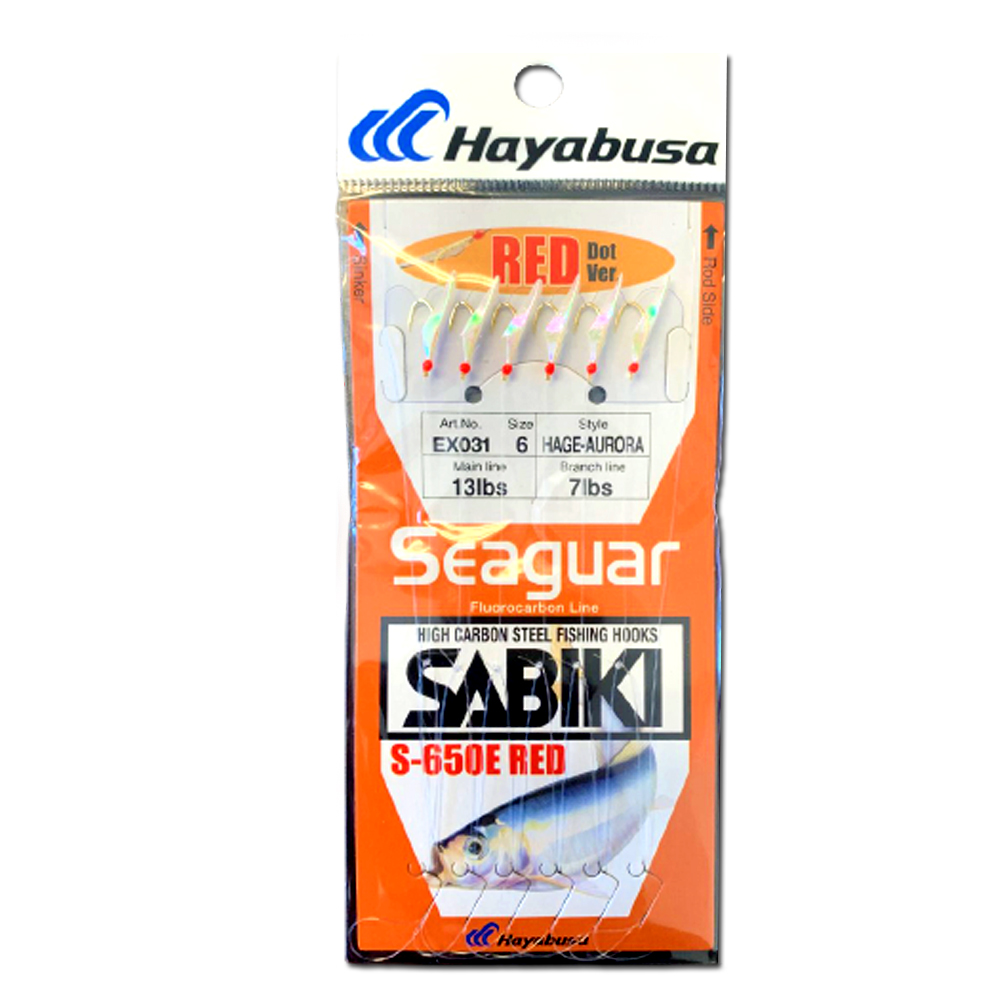
The use of sabiki rigs in the USA exploded through the late 1970s and 80s with a rush of imported and domestic versions. However, many of these brands lacked the quality in materials and workmanship of the original imported versions from Hayabusa.
It was soon discovered the sabiki rigs that worked best for cigar minnows were made with “fish skin” on the smallest hook size available (3 or 4). And rigs made with a “glow bead” in front of the hook seem to attract more sardines and small jacks (Atlantic bumper and other “hardtails” or “yellowtails”) than cigar minnows or herring. Quality components are what makes high value brand sabiki’s like Hayabusa last longer for anglers.
Even before manufactured sabiki rigs appeared on the American fishing tackle market, folks along the Gulf Coast knew how to catch their own baitfish by tying a “gold hook rig”. Some intrepid pier angler discovered how the hordes of baitfish teeming around the beach piers along the Emerald Coast would readily bite bare # 10 or #8 gold Aberdeen hooks. At only 10 cents per hook, several of these hooks can be quickly tied together (about 6 inches apart) to make a rudimentary sabiki rig for only a fraction of the cost of a premade imported sabiki. And because the bare hooks are so stealthy they often out perform the “gaudier” flies.
How To Use Sabiki Rigs
Using a Sabiki rig is a relatively straightforward process. Here’s a step-by-step guide on how to use a Sabiki rig effectively:
- Select the Appropriate Sabiki Rig: Choose a Sabiki rig based on the target species and fishing conditions. Consider factors like hook size, line strength, and attractants.
- Attach the Sabiki Rig: Tie the main line of your fishing setup to the top swivel or attachment point on the Sabiki rig. Ensure a secure connection with a suitable fishing knot.
- Add Weight (Optional): Depending on the fishing depth and current conditions, you may need to add weight to the Sabiki rig. Attach a weight, such as a sinker or split shot, to the bottom attachment point of the rig. This helps the rig sink and maintains vertical positioning in the water.
- Lower the Sabiki Rig into the Water: Cast or lower the Sabiki rig into the water where you suspect the target fish to be present. Let the rig sink to the desired depth.
- Jig and Retrieve: Once the Sabiki rig is in the water, begin a slow and steady jigging motion by lifting and dropping the rod tip. This motion mimics the movement of small baitfish and attracts the attention of the target fish.
- Monitor for Bites: As you jig the Sabiki rig, keep a close eye on your rod tip or line for any signs of movement or bites. When a fish bites, you’ll notice a distinct tug or movement on the line.
- Set the Hook: When you feel a bite or see a significant movement on the line, quickly raise the rod tip to set the hook. Maintain tension on the line to keep the fish hooked.
- Reel in the Fish: Carefully reel in the fish using a smooth and steady motion. Avoid jerking the rod or reeling too quickly, as this can cause the fish to become unhooked.
- Repeat the Process: After catching a fish or if no bites occur, repeat the process by lowering the Sabiki rig back into the water and continuing to jig and retrieve.
Remember to adhere to local fishing regulations and size limits for the target species. It’s also important to handle any caught fish with care and release undersized or unwanted fish back into the water unharmed.
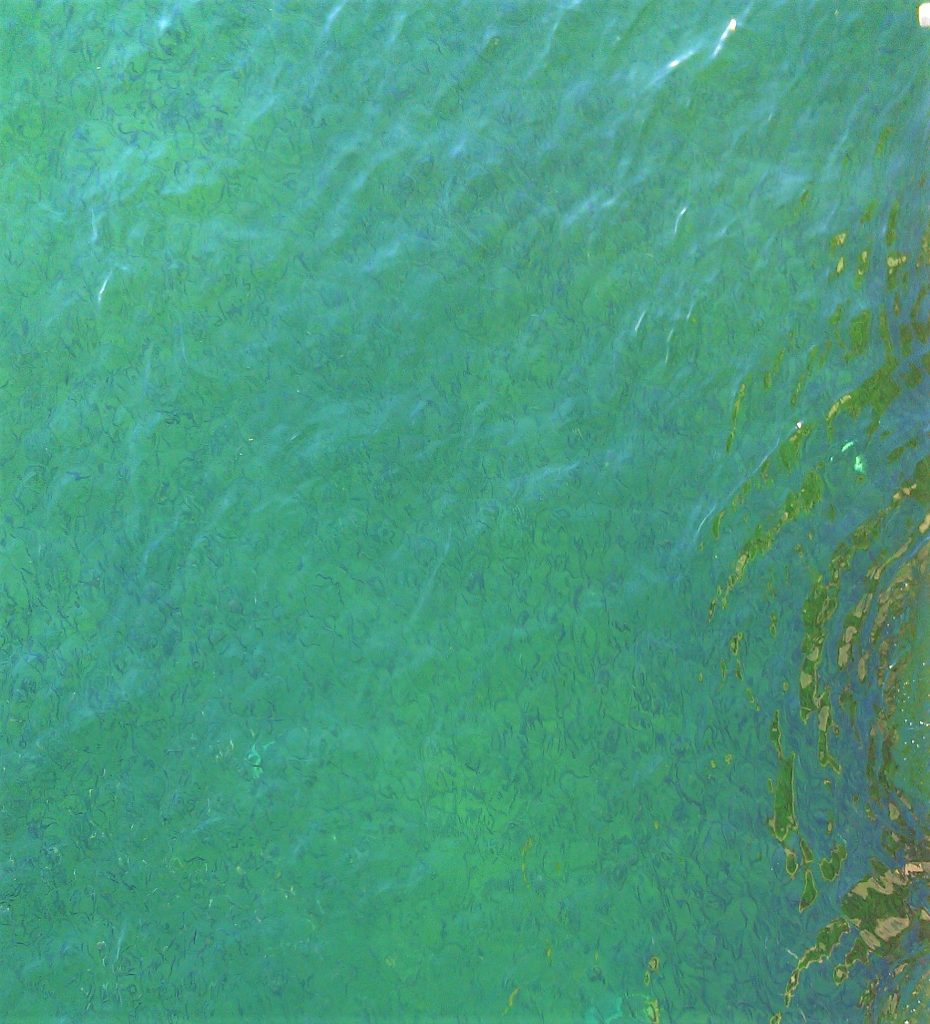
What To Look for When Choosing A Sabiki Rig
When getting a Sabiki rig, there are several factors to consider. Here are some key things to look for:
- Hook Quality: Ensure that the hooks on the Sabiki rig are of good quality and suitable for the type of fish you intend to target. They should be sharp, durable, and resistant to corrosion.
- Line Strength: Check the strength and quality of the fishing line used in the Sabiki rig. It should be able to handle the weight and size of the fish you expect to catch.
- Rig Length: Consider the length of the Sabiki rig. Longer rigs are generally suitable for deeper water or when targeting fish that stay in midwater or near the bottom. Shorter rigs are ideal for shallow water or when targeting fish near the surface.
- Number of Hooks: Sabiki rigs come in various configurations, with different numbers of hooks. Choose a rig with the appropriate number of hooks based on your fishing requirements and local regulations.
- Swivels and Connections: Pay attention to the quality of swivels and connections in the Sabiki rig. They should be strong, smooth, and reliable to prevent tangling and ensure efficient movement of the rig.
- Attractants and Flashing Material: Some Sabiki rigs include additional attractants such as feathers, beads, or reflective materials. These can increase the chances of enticing fish to bite. Consider rigs with attractive features that match the preferences of your target species.
- Ease of Use: Look for a Sabiki rig that is easy to handle and deploy. A rig with clear instructions or labeled hooks can be helpful, especially for beginners.
- Storage and Organization: Consider the packaging or storage options provided with the Sabiki rig. Some rigs come with convenient storage tubes or cases that help keep the rig tangle-free and easy to transport.
Colors For Sabiki Rigs
To pick the right Sabiki rig colors for attracting fish, follow these tips:
- Assess water conditions: Clear water may require natural or silver/chrome-colored rigs, while stained or murky water may benefit from brighter or contrasting colors like green or red.
- Research local prey species: Learn about prevalent baitfish species and match their coloration with corresponding Sabiki rig colors to increase your chances of enticing the target species.
- Experiment with different colors: Fish preferences can vary based on weather, time of day, and water conditions. Carry a selection of Sabiki rigs in different colors to test what works best on any given day.
- Consider seasonal changes: Adapt your Sabiki rig color choices to match seasonal changes in baitfish populations. For example, silver or chrome-colored rigs may work well during seasons with an abundance of small silver baitfish.
- Seek local advice: Stay updated with local fishing reports and consult experienced anglers for insights on effective Sabiki rig colors based on recent fishing conditions and trends.
- Trust your instincts: Personal experiences and instincts can guide your color choices. If you’ve had success with a particular color in the past or noticed positive fish reactions, trust your intuition.
There is no one-size-fits-all approach to Sabiki rig colors. Adaptability and willingness to try different colors based on water conditions, baitfish species, and local advice are key. Over time, you’ll develop a better understanding of which colors work best in various fishing situations, increasing your chances of success.
Sabiki Rig Weights
Sabiki bait rigs perform best when the amount of weight allows a slow fall through the bait school in the conditions present. Too much weight, and the rig plummets through the school too quickly. Also a large splash and weight may spook skittish baitfish. But if the weight is too light, it tangles easily, rendering it useless. Choosing the style of weight can make a difference too. Teardrop shaped weights will usually perform better than pyramid shaped ones, which offer more resistance underwater and slow the action. And the end of a bank style sinker is often too large to fit inside the snap swivel at the end of the sabiki. The weight style known as “bass casting” is teardrop shaped and has a small brass ring that fits even the smallest terminal snap swivel.
Sabiki Rig Hook Size
One of the trickiest things for American anglers to understand is the hook sizing difference between those made in Japan from the United States versions. Labeling numbers of smaller Japanese sabiki hook sizes (3 and 4) work best for smaller baitfish like cigar minnows, sardines or herring. These are equivalent to #16, #14 or #12 size hooks made in the USA. The main line and the branch line (to each fly) are made of very light monofilament (4 or 6 pound test) or even fluorocarbon so they don’t spook the small fish.
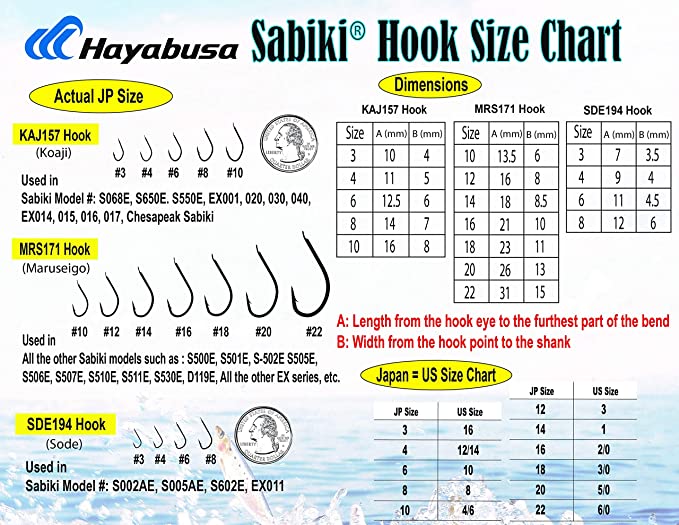
The imported sabiki sizes 6, 8, and 10 respectively correspond to #10, #8 and #6 size USA hooks. These work better on mid-sized baitfish like “turbo cigs”, jumbo sardines and herring, or for small hardtails (like blue runners). Both the main line and the branch lines are made with slightly heavier mono to help prevent break offs. Break offs commonly occur when too many or too large of fish are pulling in different directions. Another inherent problem is the sharp teeth of small mackerel and bluefish cutting through the light lines. Not much can be done about these downfalls except to open your wallet and tie on another rig.
Some anglers do target spanish mackerel and bluefish with the larger sized sabiki rigs size 20 and 22. These feature larger flies on heavier line (20 to 40 pound monofilament to better protect the inch and a half long lures from being bitten off by the toothy fish. They are also effective for non-regulated species such as blue runner (“hardtails”), and ladyfish (“skipjack”). Many times these intermediate predatory fish are used as bait (live, or cut) for even bigger gamefish ranging from “bull” redfish to sharks and even marlin.
Other Uses For Sabiki Rigs
Anglers even find sabiki rigs useful to bottom fish for pinfish, pigfish, grunts, croakers, kingfish (“whiting”) and even seatrout (“white trout”). All of these species, are commonly used as baitfish (whole or cut up) for larger offshore species like red snapper, amberjack and king mackerel. Simply adding a small piece of bait (shrimp, fish or squid) to the hooks, or even a small strip of synthetic bait like Fishbites gives the flies the added attractiveness of scent. Incidentally, a lot of spadefish are caught on small hook sabiki rigs tipped with ½ inch long slivers of Fishbites.
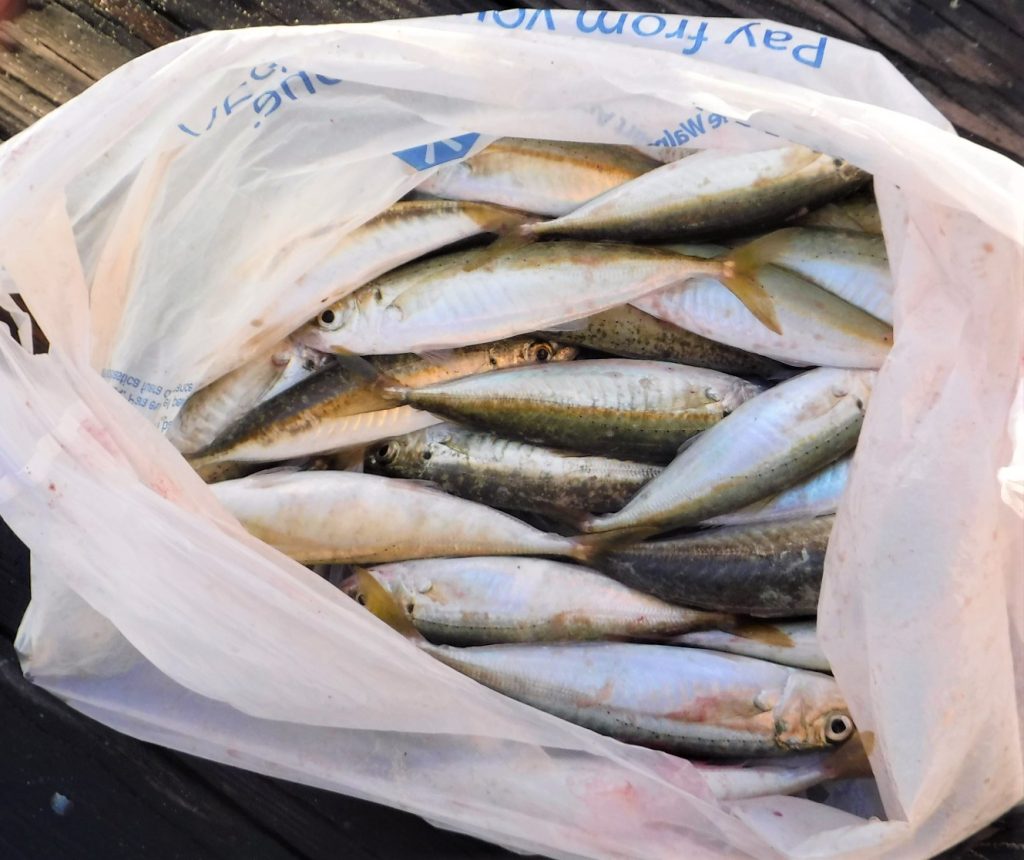
Useful Sabiki Rig Fishing Items
The bait de-hooker is a handy little device with a short piece of non bendable wire with a curve on the end. The curve slides down the line to the mouth of the baitfish. Then with the flick of a wrist, the baitfish pops off the hook and falls into the bait well or bucket without any of its protective slime being removed. Such bait stays healthier longer and performs better. These cost only a few dollars.
The sabiki rod is a five foot long hollow tube with a mounted bait casting reel that safely stores the sabiki rig. The line comes off the reel and enters the tube through a small hole, then feeds through and out the other end. This way, the rig can be reeled into the tube for safe storage to prevent tangling and accidental hooking, which is a hazard of so many tiny yet ultra sharp fish hooks. They do cost in excess of $50, but that is recouped in being able to use the same sabiki rig for a number of fishing trips with added safety.
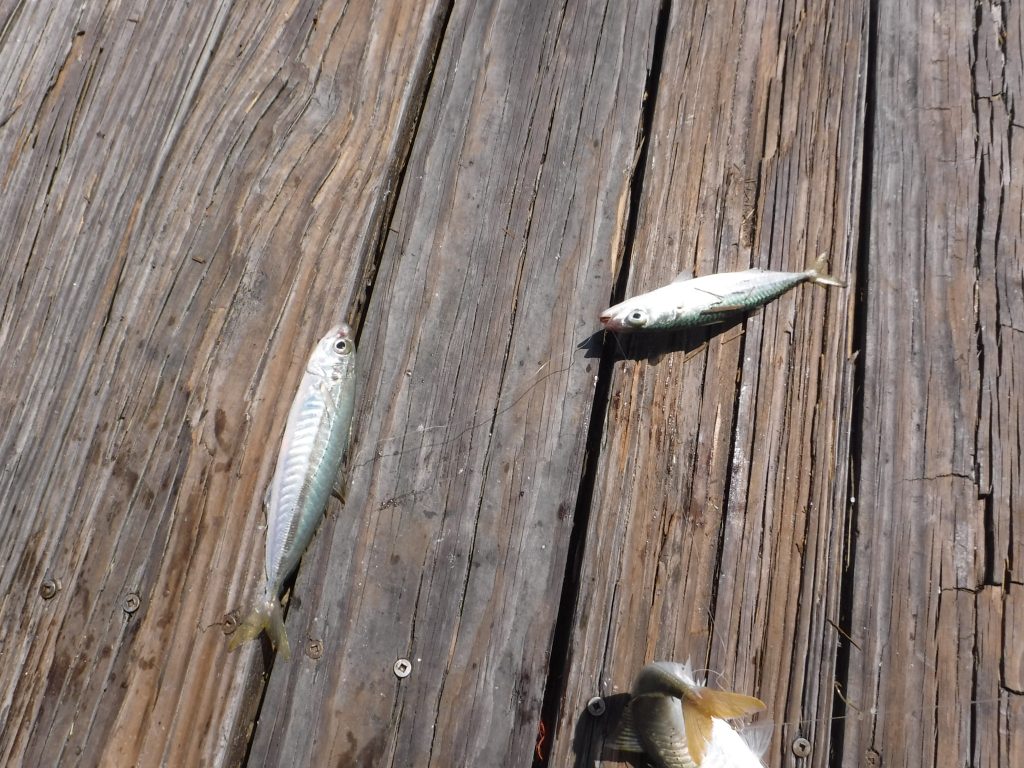
There remains a certain satisfaction in catching, that is “making” your own bait. And being able to do that efficiently, that is catching multiple baitfish on each drop minimizes the actual pre fishing time that can make, or break your day, and your budget.
Final Thoughts On Choosing The Best Sabiki Rig
In conclusion, selecting the best Sabiki rig for making bait is crucial for successful fishing trips. By considering factors such as hook quality, line strength, rig length, number of hooks, swivels and connections, attractants, ease of use, and storage options, anglers can make informed decisions that align with their fishing goals and local regulations. Remember to choose a Sabiki rig that suits the target species and fishing conditions, and follow proper techniques for rigging and deployment. With the right Sabiki rig in hand, anglers can enhance their chances of attracting and catching baitfish efficiently, leading to more productive and enjoyable fishing experiences.
Full Disclosure: This post may include affiliate links. There’s no extra charge to our readers for using these.




